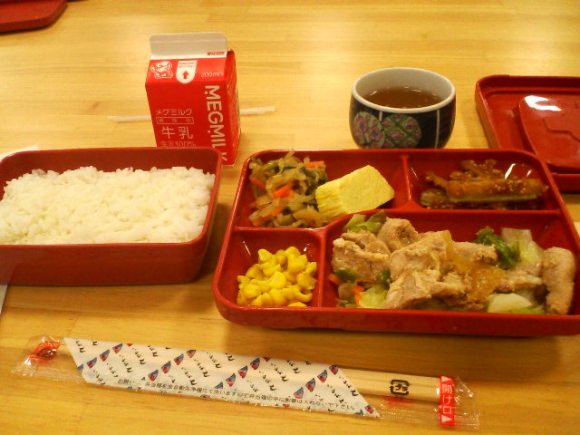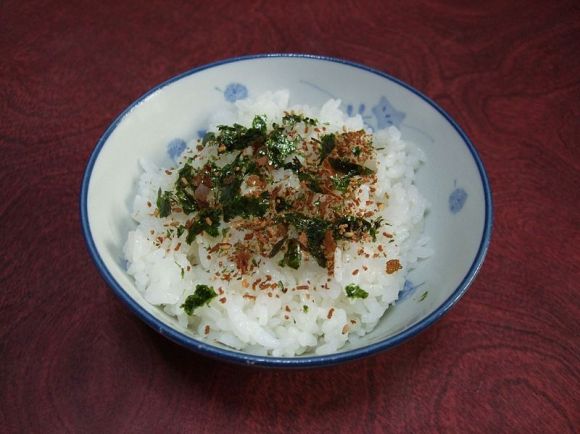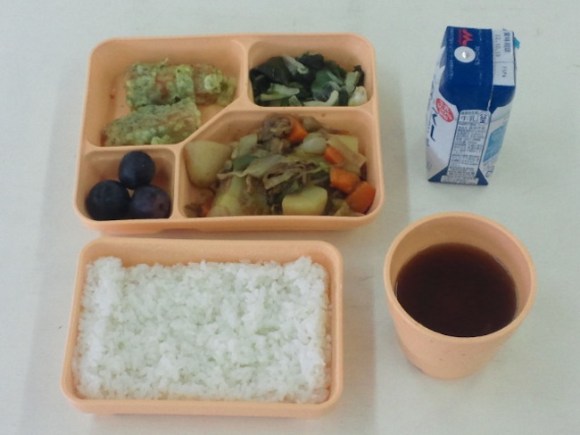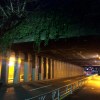
He’s known for his outspoken and often controversial opinions, from saying that civil servants who have tattoos should resign, to denying the forcible recruitment of South Korean “comfort women” during the second world war.
But it was an intense debate about whether students should be allowed to have furikake seasoning with their school lunch that left city mayor Tōru Hashimoto scratching his head this week as he asked the Osaka Board of Education: “What’s wrong with furikake?!”
Cold, unappetising and tasteless is how junior high students in Osaka describe their school lunches. And kids have been voting with their chopsticks, leaving lunches uneaten. With 70 percent of students failing to finish their school lunch, the city Board of Education has been discussing ways to get them to clear their plates.
“More students might eat their rice if they could have furikake [with school lunch]”, teachers suggested in a meeting on Tuesday. Mayor Hashimoto then asked in amazement, “Furikake wa dame nan desu ka?”, which translates as “Huh? What’s wrong with furikake?” or “Why can’t they have furikake?”
Furikake is a flaked flavouring that is sprinkled on rice. It comes in all kinds of flavours, but it’s typically fishy with seaweed, and is a popular and effective way to get Japanese kids to eat up their bowl of plain rice.
▼ Furikake: Looks weird, tastes great.
So what’s the problem with furikake? Well, typically, school lunches in Japan are rice-heavy and well-balanced. But furikake is high in salt, and allowing kids to use it might undo the careful balance of the healthy meal they’re being served. On the other hand, some say that the negative effects of higher salt intake might be offset by the benefit of students actually finishing their meals.
School meal uptake in Japan is impressively high, and students are expected to eat the whole thing with no leftovers. But in Osaka, where bringing lunch from home has long been the norm, school lunches are a recent development. In 2011, only 11 percent of junior high students in Osaka were having a “full school lunch” including milk, compared to a national average of 76 percent. Amid concern that some homemade lunches were not healthy enough, school lunches were rolled out across the city.
▼ Iced buns, while delicious, do not a healthy lunch make.
But to keep costs down, lunches in Osaka are prepared elsewhere, refrigerated, and delivered to schools. The problem is, lots of kids don’t like chilled lunch.
▼ And who can blame them? Meat and potato stew, straight from the fridge.
On the furikake question specifically, the debate lasted 10 minutes and did not come to any concrete conclusions; the board decided to consult with experts before taking any further action. Will flaked seasonings be allowed in Osaka’s schools? Hashimoto was insistent that schools must be allowed to decide for themselves without interference from the city government: “If we can’t even let schools decide about furikake…”
Sources: Sankei Shimbun/Yahoo, Naver Matome
Featured image: awatajinja




 Furikake rice seasoning sales are soaring, which is bad news for Japan as a whole
Furikake rice seasoning sales are soaring, which is bad news for Japan as a whole School Lunch in Japan 【You, Me, And A Tanuki】
School Lunch in Japan 【You, Me, And A Tanuki】 Top 10 Japanese school lunch food items that adults miss the most
Top 10 Japanese school lunch food items that adults miss the most Itadakimasu! A brief history of the evolution of Japanese school lunches
Itadakimasu! A brief history of the evolution of Japanese school lunches Mayor of Osaka wants to legally control when kids can and can’t use smartphones in their own home
Mayor of Osaka wants to legally control when kids can and can’t use smartphones in their own home Ramen restaurant’s English menu prices are nearly double its Japanese ones, denies discriminating
Ramen restaurant’s English menu prices are nearly double its Japanese ones, denies discriminating Here’s what our bachelor writers ate over the New Year’s holiday in Japan
Here’s what our bachelor writers ate over the New Year’s holiday in Japan Nearly one in ten young adults living in Japan isn’t ethnically Japanese, statistics show
Nearly one in ten young adults living in Japan isn’t ethnically Japanese, statistics show Rakuten randomly offers 58 New Year’s osechi feasts in Japan, but did we get a star or a dud?
Rakuten randomly offers 58 New Year’s osechi feasts in Japan, but did we get a star or a dud? What makes a good boss in Japan? Workers sound off in survey
What makes a good boss in Japan? Workers sound off in survey Japanese beef bowl chain Sukiya’s 2026 Smile Box lucky bag basically pays for itself
Japanese beef bowl chain Sukiya’s 2026 Smile Box lucky bag basically pays for itself New Studio Ghibli die-cast anime cars on their way, even if neither one is really a car【Pics】
New Studio Ghibli die-cast anime cars on their way, even if neither one is really a car【Pics】 We investigate Sendagaya Tunnel and get a message from beyond【Haunted Tokyo】
We investigate Sendagaya Tunnel and get a message from beyond【Haunted Tokyo】 U.S.A. now the fastest-growing market for Japan’s high-tech toilets, now selling quicker than ever
U.S.A. now the fastest-growing market for Japan’s high-tech toilets, now selling quicker than ever Burger King Japan’s Ugly Burgers go head-to-head in a battle for flavour
Burger King Japan’s Ugly Burgers go head-to-head in a battle for flavour Starbucks Japan ready to get Year of the Horse started with adorable drinkware and plushies【Pics】
Starbucks Japan ready to get Year of the Horse started with adorable drinkware and plushies【Pics】 Hayao Miyazaki says Happy New Year to Studio Ghibli fans with new art for Year of the Horse
Hayao Miyazaki says Happy New Year to Studio Ghibli fans with new art for Year of the Horse Cup Noodle tries an authentic Jiro-style ramen, but something’s not quite right
Cup Noodle tries an authentic Jiro-style ramen, but something’s not quite right Top Japanese cosplayer Enako returns to Comiket after 6 years, creates mayhem with admirers
Top Japanese cosplayer Enako returns to Comiket after 6 years, creates mayhem with admirers The best Starbucks Japan Frappuccinos we want to drink again in 2026
The best Starbucks Japan Frappuccinos we want to drink again in 2026 We revisited Sweets Paradise after a decade to see if Japan’s dessert buffet still delivers
We revisited Sweets Paradise after a decade to see if Japan’s dessert buffet still delivers That time Seiji called JASRAC to ask why he didn’t get paid royalties for his song being on TV
That time Seiji called JASRAC to ask why he didn’t get paid royalties for his song being on TV Pizza Hut Japan’s hot lucky bags are perfect for a New Year’s pizza party
Pizza Hut Japan’s hot lucky bags are perfect for a New Year’s pizza party Majority of Japanese mayors say foreign residents are essential but most see good and bad effects
Majority of Japanese mayors say foreign residents are essential but most see good and bad effects 7-Eleven Japan starts new temporary luggage storage service in over 300 branches
7-Eleven Japan starts new temporary luggage storage service in over 300 branches Disillusionment at Tsukiji’s tourist-target prices led us to a great ramen restaurant in Tokyo
Disillusionment at Tsukiji’s tourist-target prices led us to a great ramen restaurant in Tokyo Starbucks teams up with 166-year-old Kyoto doll maker for Year of the Horse decorations【Photos】
Starbucks teams up with 166-year-old Kyoto doll maker for Year of the Horse decorations【Photos】 Tokyo considering law requiring more trash cans following litter increase in heavily touristed area
Tokyo considering law requiring more trash cans following litter increase in heavily touristed area Tokyo’s Tsukiji sushi neighborhood asks tour groups to stay away for the rest of the month
Tokyo’s Tsukiji sushi neighborhood asks tour groups to stay away for the rest of the month Tokyo event lets you travel back in time, for free, to celebrate 100 years since Showa era start
Tokyo event lets you travel back in time, for free, to celebrate 100 years since Showa era start Japan may add Japanese language proficiency, lifestyle classes to permanent foreign resident requirements
Japan may add Japanese language proficiency, lifestyle classes to permanent foreign resident requirements Sanrio theme park in Japan announces plans to expand into a Sanrio resort
Sanrio theme park in Japan announces plans to expand into a Sanrio resort Lacquerware supplier to emperor of Japan and Pokémon team up for new tableware
Lacquerware supplier to emperor of Japan and Pokémon team up for new tableware Survey asks foreign tourists what bothered them in Japan, more than half gave same answer
Survey asks foreign tourists what bothered them in Japan, more than half gave same answer Japan’s human washing machines will go on sale to general public, demos to be held in Tokyo
Japan’s human washing machines will go on sale to general public, demos to be held in Tokyo Japan’s deadliest food claims more victims, but why do people keep eating it for New Year’s?
Japan’s deadliest food claims more victims, but why do people keep eating it for New Year’s? We deeply regret going into this tunnel on our walk in the mountains of Japan
We deeply regret going into this tunnel on our walk in the mountains of Japan Studio Ghibli releases Kodama forest spirits from Princess Mononoke to light up your home
Studio Ghibli releases Kodama forest spirits from Princess Mononoke to light up your home Major Japanese hotel chain says reservations via overseas booking sites may not be valid
Major Japanese hotel chain says reservations via overseas booking sites may not be valid Put sesame oil in your coffee? Japanese maker says it’s the best way to start your day【Taste test】
Put sesame oil in your coffee? Japanese maker says it’s the best way to start your day【Taste test】 No more using real katana for tourism activities, Japan’s National Police Agency says
No more using real katana for tourism activities, Japan’s National Police Agency says Starbucks Japan reveals new sakura drinkware collection, inspired by evening cherry blossoms
Starbucks Japan reveals new sakura drinkware collection, inspired by evening cherry blossoms Updated cherry blossom forecast shows extra-long sakura season for Japan this year
Updated cherry blossom forecast shows extra-long sakura season for Japan this year “How I learned to stop worrying and eat Japanese school lunches,” by P.K. Sanjun
“How I learned to stop worrying and eat Japanese school lunches,” by P.K. Sanjun Our Japanese reporter’s encounter with American school lunch
Our Japanese reporter’s encounter with American school lunch Osaka’s new remote-learning policy leaves teachers strained and forces students to go to school
Osaka’s new remote-learning policy leaves teachers strained and forces students to go to school Japanese school lunch noodles fried so hard that children and teachers chip teeth, go to hospital
Japanese school lunch noodles fried so hard that children and teachers chip teeth, go to hospital Human pyramids continue in Kobe schools as injuries mount to 51, mayor’s pleas to stop unanswered
Human pyramids continue in Kobe schools as injuries mount to 51, mayor’s pleas to stop unanswered No school lunches? Tokyo boxed lunch stand says kids have to pay, but doesn’t care when, to whom
No school lunches? Tokyo boxed lunch stand says kids have to pay, but doesn’t care when, to whom Tokyo government building serves local school lunch to public in Japanese cafeteria
Tokyo government building serves local school lunch to public in Japanese cafeteria Foreign student’s comment leads to Japan’s favorite tonkotsu ramen being added to school lunch menu
Foreign student’s comment leads to Japan’s favorite tonkotsu ramen being added to school lunch menu Japanese survey takers go back to school to vote on their favorite school lunch menu items
Japanese survey takers go back to school to vote on their favorite school lunch menu items Japanese town axes milk from school lunches, debate likely to wage until cows come home
Japanese town axes milk from school lunches, debate likely to wage until cows come home
Leave a Reply